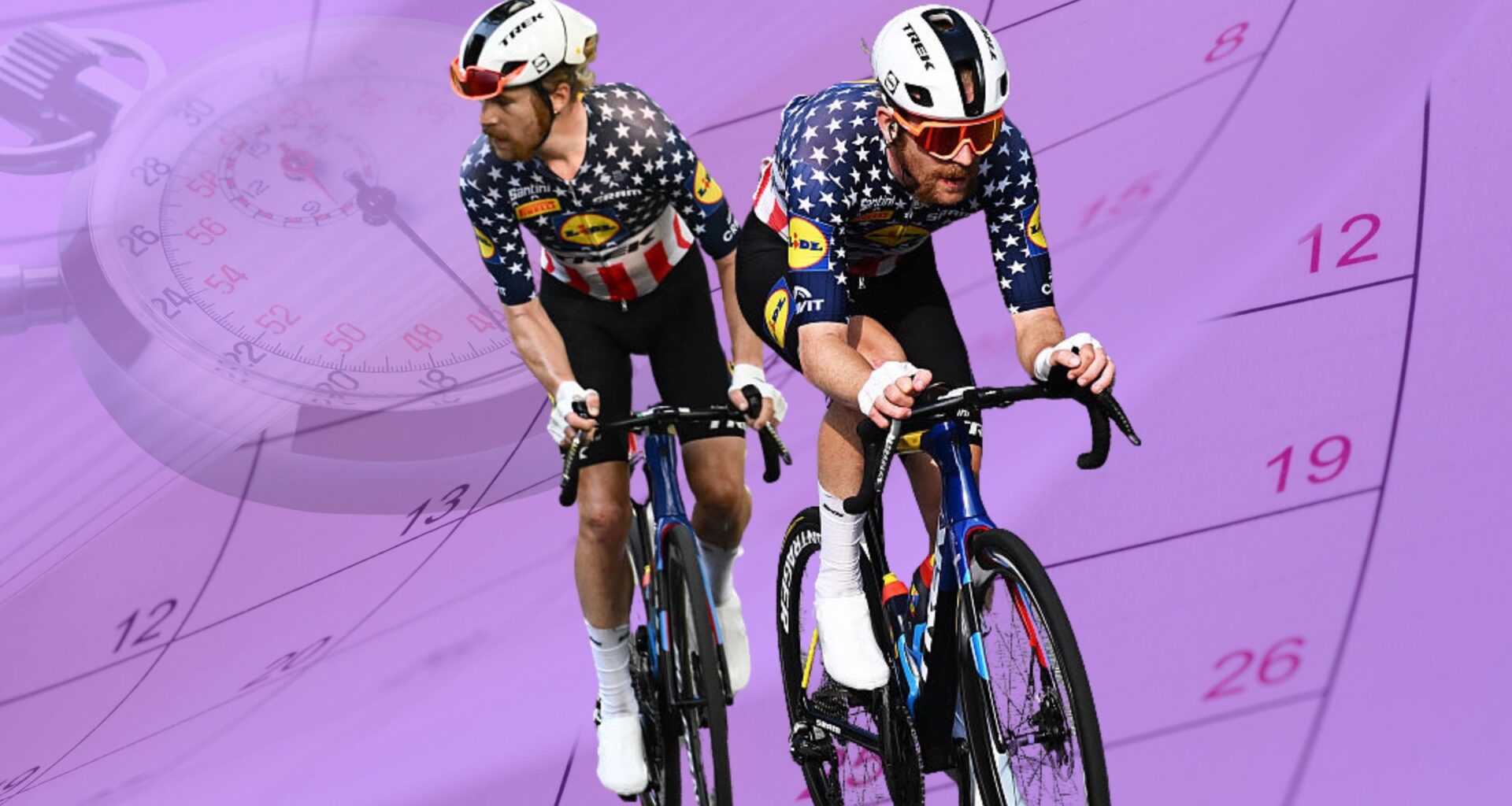Updated November 7, 2025 05:07AM
Quinn Simmons trains like an animal, eats like a horse, and doesn’t buy into any B.S.
They’re the key takes from a fascinating interview the U.S. slugger gave to training outfit EVOQ Bike.
It’s a long conversation that gives unflinching, deep-dive details of WorldTour performance. It proves rare insight into what it takes to survive monument breakaways with Tadej Pogačar, attack for more than 500km of the Tour de France, and win stages at two of the WorldTour’s biggest races.
And while Simmons’ performance program is far beyond that of us weany-watt wannabes, there are lessons to be learned from his approach.
Here are three useful takeaways from the insane training regimen of Lidl-Trek’s-own “Captain America.”
1: No shortcuts: ‘The biggest factor is doing the work’
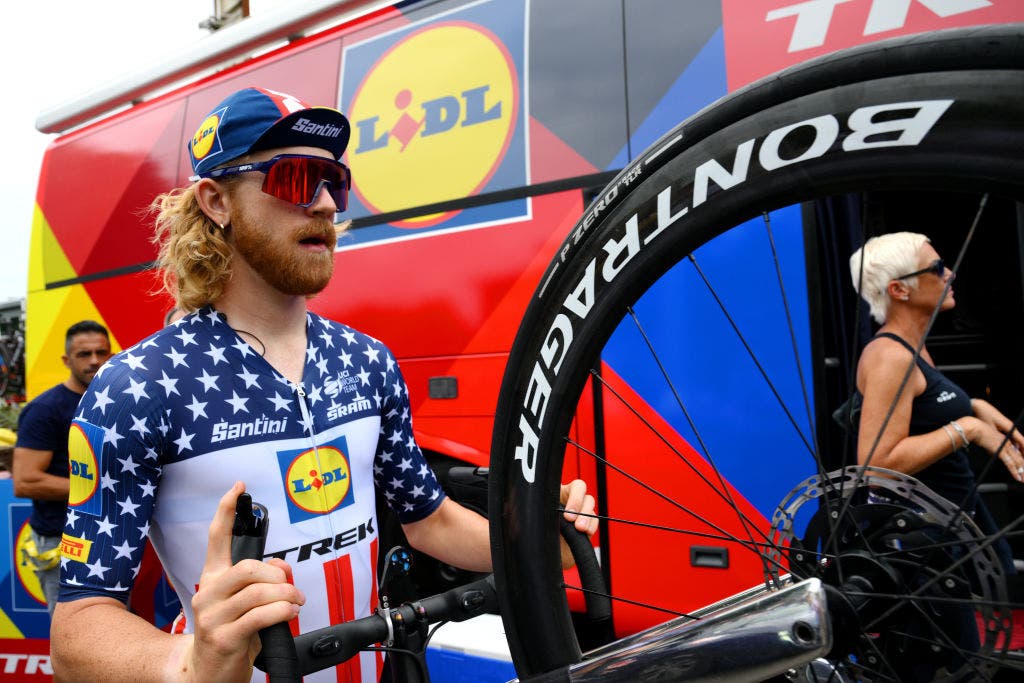 Simmons believes the most important part of training is showing up, day-in, day-out. (Photo: David Ramos/Getty Images)
Simmons believes the most important part of training is showing up, day-in, day-out. (Photo: David Ramos/Getty Images)
Accept that training can suck
The overarching theme of “The Simmons Method?” That the 24-year-old approaches training with a sledgehammer.
The Durango-native told EVOQ he makes up for a lack of Pogi-esque genetics with a bullish commitment to “doing the work.”
“The biggest thing [for success] is you just have to train,” Simmons said. “It’s 28 to 30 hours on the bike per week, and you have to do it week-in, week-out.
“There’s no, ‘oh, I have this goal race a month from now, it’s time to do a big block.’ The ‘big block’ starts in November, and you have to repeat it week after week,” he said.
Simmons believes some wannabe pros don’t dare accept the painful reality of endurance training.
“[People don’t do it because] it’s hard,” he said. “People don’t like doing hard things.”
And yes, WorldTour training is very hard.
Simmons sketched out devastating training sessions set by his trainer Steven de Jongh focused on durability, torque, and race-simulation. As is the current trend, his long endurance rides are at a high zone 2 that requires constant, “hard but comfortable” pressure through the pedals.
What works for one doesn’t work for all
 Simmons’ all-in ethic made him strong enough to hang with Pogačar, but has put him into a hole. (Photo: MARCO BERTORELLO/AFP via Getty Images)
Simmons’ all-in ethic made him strong enough to hang with Pogačar, but has put him into a hole. (Photo: MARCO BERTORELLO/AFP via Getty Images)
But not all riders are the same.
Simmons largely trains solo and favors a grueling, volume-heavy program that’s probably unlike that of any of his Lidl-Trek teammates. It’s a reminder that while elite training is tracked and measured by a science-lab of wearables, head units, and performance monitors, its refined by a trial and error of learning what works.
“I’m one of these guys that recovers quite well, so I can train quite hard day-in, day-out,” Simmons told EVOQ, suggesting what makes him unique.
“I don’t have a crazy peak sprint or a crazy hour-power, and my watts per kilo is nothing special. But as long as I feel right and I take care of the recovery, I can go day-in, day-out.”
But even after six years as a pro, Simmons still doesn’t always get it right.
“A few times, I’ve gone over the limit with finding how deep I can push,” he said, before qualifying that a planned overreach can be a good thing – provided you allow time to recover.
“Sometimes you do have to go over that limit,” Simmons said. “[At the end of a training block] I’ll do something like three rides that are all six to seven hours and really finish myself. But then I’ll not be afraid to take four coffee rides in the days after [to recover].”
The Simmons Method is brutal … but realistic. There’s recognition of when to back off.
Commit like a pro?
Sadly, you’re not going to crush your Cat. A Zwift race or claim all yours local Strava KoMs without a little effort.
And as Simmons suggests, endurance training isn’t all sunshine and rainbows.
If you want the results – whether that’s in the WorldTour, in a grassroots crit, or to satisfy your private fitness goals – you’ve got to do hard work.
Don’t commit like a pro?
Obviously, if you’re an amateur, don’t go training for 28 to 30 hours a week.
Simmons’ huge work capacity makes him an outlier, even among the physiological freaks of the WorldTour. And more to the point, you’ll fall out with your boss, your spouse, and your legs if you try to mimic his mega-mileage.
Further to that, be careful scheduling a “functional” overreach unless you work with a trainer. Overreaching and overtraining are separated by only a matter of hours.
2: Calories are controlled, but cake is often neccessary
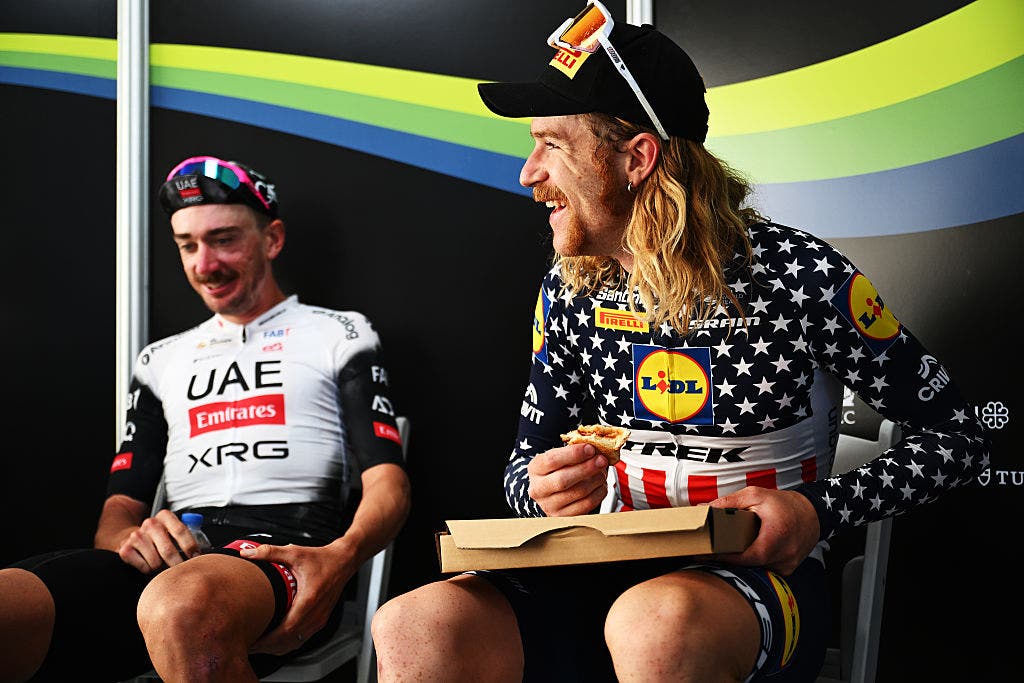 Simmons admitted he has an unhealthy relationship with food – as do most pros. (Photo: Szymon Gruchalski/Getty Images)
Simmons admitted he has an unhealthy relationship with food – as do most pros. (Photo: Szymon Gruchalski/Getty Images)
Off-bike diet
Simmons blends a paradoxical mix of extreme discipline and reasoned freedom to his diet. It’s meticulous calorie control served with a slab of cake for afters.
“I don’t eat anything without it going on the scale first,” Simmons said, probably only half-joking.
The 24-year-old told EVOQ that, like most pros, he’s developed a dangerous relationship with what’s his plate.
“I started with a nutritionist two years ago. We talk about the negative relationship with food, and for sure, all of us are definitely a little loopy with the food,” Simmons told EVOQ.
“But then again, it’s our job, so you can’t really complain too much.”
Simmons, who admitted he has to be wary not to overeat, is shadowed by the obsession with food that stalks pro cyclists.
“It’s not going to be the most healthy thing ever to be weighing your apple, but we have a weight we have to make, and we have a certain amount of carbs we have to hit to perform,” he said.
“Not much that we do in training is super healthy long term,” Simmons continued. “But it’s 10-15 years of your life. You kind of just have to suck up that it sucks and go for high performance.”
But here’s the most intriguing takeaway – Simmons isn’t suffering endless bowls of quinoa, kale, and chicken fillet.
There’s another “c” sound in Simmons’ 7,000-calorie diet.
“If I have 700 calories left at the end of the day, I’ll go buy a cake or something,” he admitted.
More now than ever, pro cycling is a power sport that fuels as hard as it races.
The macronutrient goals kicked out by custom apps prioritize adequate fueling for performance and recovery before strength-sapping weight-loss.
Simmons tracks his food to ensure he’s eating enough, but not too much.
On-bike fueling
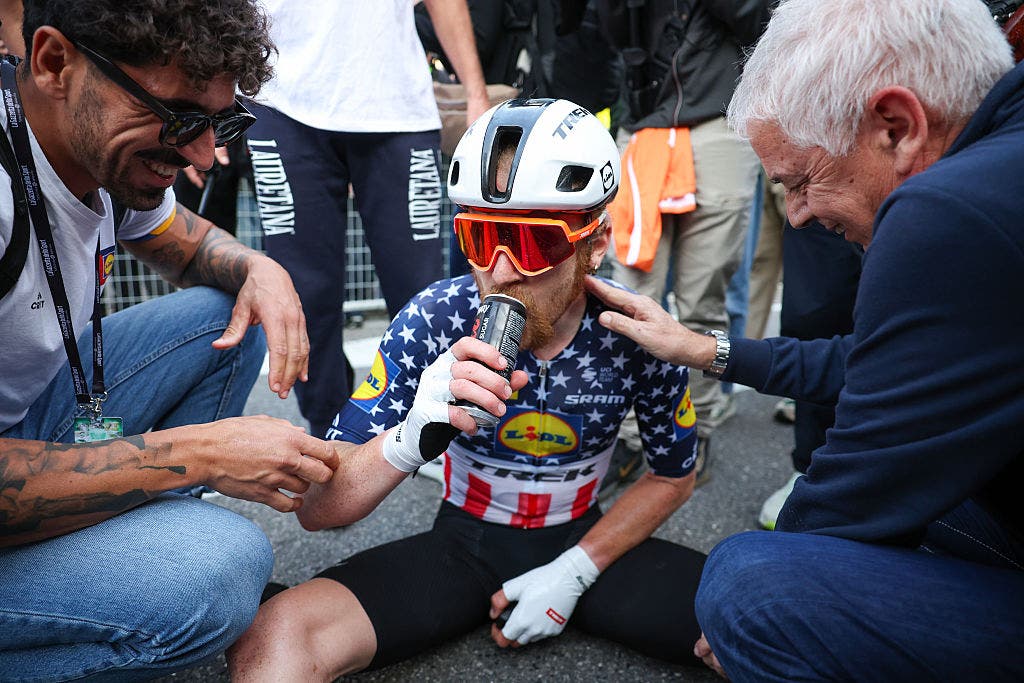 Simmons eats to prioritize performance and recovery, which means calories come in all forms available. (Photo: Sara Cavallini/Getty Images )
Simmons eats to prioritize performance and recovery, which means calories come in all forms available. (Photo: Sara Cavallini/Getty Images )
Simmons explained to EVOQ that calorie-bombs aren’t only for late-night emergencies.
They extend to the bike.
“I don’t purely just eat carbs [e.g. gels and chews – ed.] on a ride. I do the normal gas station food. For me, I think that feels better,” Simmons said.
Simmons fuels his training at the 120g carbohydrates per hour he targets in racing, and joked that “fasted recovery rides got thrown out really quick.”
Not everyone can stomach the “gold standard” 120g carbohydrate rate. And just like sugar tolerance is unique to every rider, so are the snacks of choice. While old-school bananas and rice cakes are becoming extinct from the racing peloton, don’t be fooled into thinking pros only fuel on gels and carb drinks.
Simmons loads up with bucket-size bowls of cornflakes before training rides, and “Captain America” eats like a kid on the bike, too.
“In a race, 90 percent of the time, you do the right thing and take the gels, but a lot of times you see me go back to the car and I’ll have a candy bar in there,” he said.
“At the nationals I had my dad on the side of the road with a few candy bars for the last couple hours,” he continued.
You can be sure that very few riders are hammering Hershey’s and scoffing Snickers deep into a one-day classic – they’re less energy efficient than sports nutrition, and logistically awkward.
But they’re certaintly not holding back Simmons, who just enjoyed his best pro season.
Fuel like a pro?
Calorie control is an awful but inescapably effective part of pro performance.
If you choose to track calories to try to improve your watts per kilo, be like Quinn.
Use the numbers to ensure discipline either side of your fueling goals. Simmons uses calorie targets to ensure he doesn’t eat too much, but he also uses them to be certain he has enough.
And lastly, eat what works for you.
Don’t like gels? Candies and cookies aren’t optimal, but they’re a much tasier solution than bonking and burnout.
Don’t fuel like a pro?
No matter how controlled you choose to be, don’t weigh you apples. Take it from a recovering anorexic – it’s not worth it.
3: Do the basics and ignore the noise
 Simmons won big with a 19km solo attack at Tour de Suisse. (Photo: Tim de Waele/Getty Images)
Simmons won big with a 19km solo attack at Tour de Suisse. (Photo: Tim de Waele/Getty Images)
No fads
Simmons goes big on the basics and doesn’t buy into any B.S.
Because let’s face it, the world of endurance is becoming complicated.
New dietary hacks, training fads, and “magic bullet” solutions appear on social feeds with every passing doomscroll. Even at the scientifically-approved WorldTour level, there are ketones, broccoli shots, blood flow restriction bands, complex plyometrics programs, and so much more.
Simmons told EVOQ he’s tuned out all-but the essentials.
“This year, I stopped doing anything extra or weird, and I just went back to training hard and eating a lot. I don’t take ketones anymore, and I don’t do any of that [extra] stuff,” he said.
“I had one kick where I did six months without eating sugar off the bike,” he continued. “But I don’t really know why I did that … it was not a super great way to live.”
But also no strength
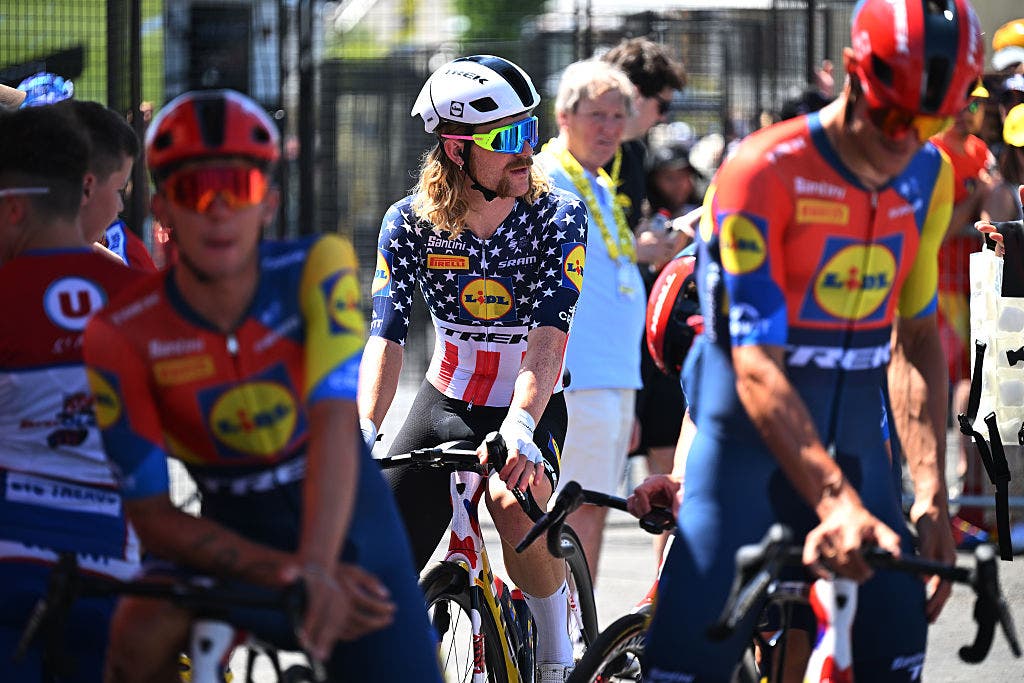 Simmons’ unique approach to performance is a reminder that there’s no ‘one size fits all.’ (Photo: Tim de Waele/Getty Images)
Simmons’ unique approach to performance is a reminder that there’s no ‘one size fits all.’ (Photo: Tim de Waele/Getty Images)
Like so many others in the post-pandemic peloton, Simmons doesn’t do any fasted training. He also revealed he rejected a team trend for early-morning running, and that he bypasses the gym.
“I used to do a lot of strength work, but this year, I completely stopped doing any lifting and just do core,” Simmons told EVOQ.
“I spent so much time doing deadlifts and squats, but I never really felt anything on the bike. It felt that it was taking away a bit from the training on the bike. It’s also just one more mental stress,” he said.
Strength training remains a divisive topic in the pro peloton.
The benefits for bone health and injury prevention means lifting heavy is encouraged more than ever before. But on the flipside, trainers won’t force a weights program unless its 100 percent necessary.
Imbalances, weaknesses, and post-injury rehab are the main enforcing factors.
That’s why Simmons is spared the suffering of “leg day” but can’t avoid doing his crunches.
“I do a lot of core stability because I’ve had lower back problems before,” he explained.
Go basic?
Simmons’ super-basic approach is a rarity. Most riders in the pro peloton will guzzle ketones, lift barbells, and dabble with the latest “marginal gain.”
But there’s a lot to learn from Simmons’ no-nonsense regime. He does what really matters by training hard, eating big, and you can bet he sleeps like a baby, too.
Be like Simmons and focus on the 99.9 percenters. Don’t “major in the minors,” because no biohacking shill can fix a shoddy diet or half-assed workout.
Don’t go basic?
Cross training and heavy lifting can be beneficial for all cyclists. Yes, they require the sacrifice of saddle time and the despair of quad DOMs. But the benefits to bone health, power output, and hormonal longevity far outweigh those things.
In Simmons’ defense – he has been known to cross country ski in the winter. Like running and hiking, skiing is highly rated by trainers looking to safeguard riders from osteoperosis.
Editor’s note:
Kudos to the team at EVOQ Bike for a fascinating interview. We urge you to go check out the full long-form interview with Simmons on their YouTube channel.

